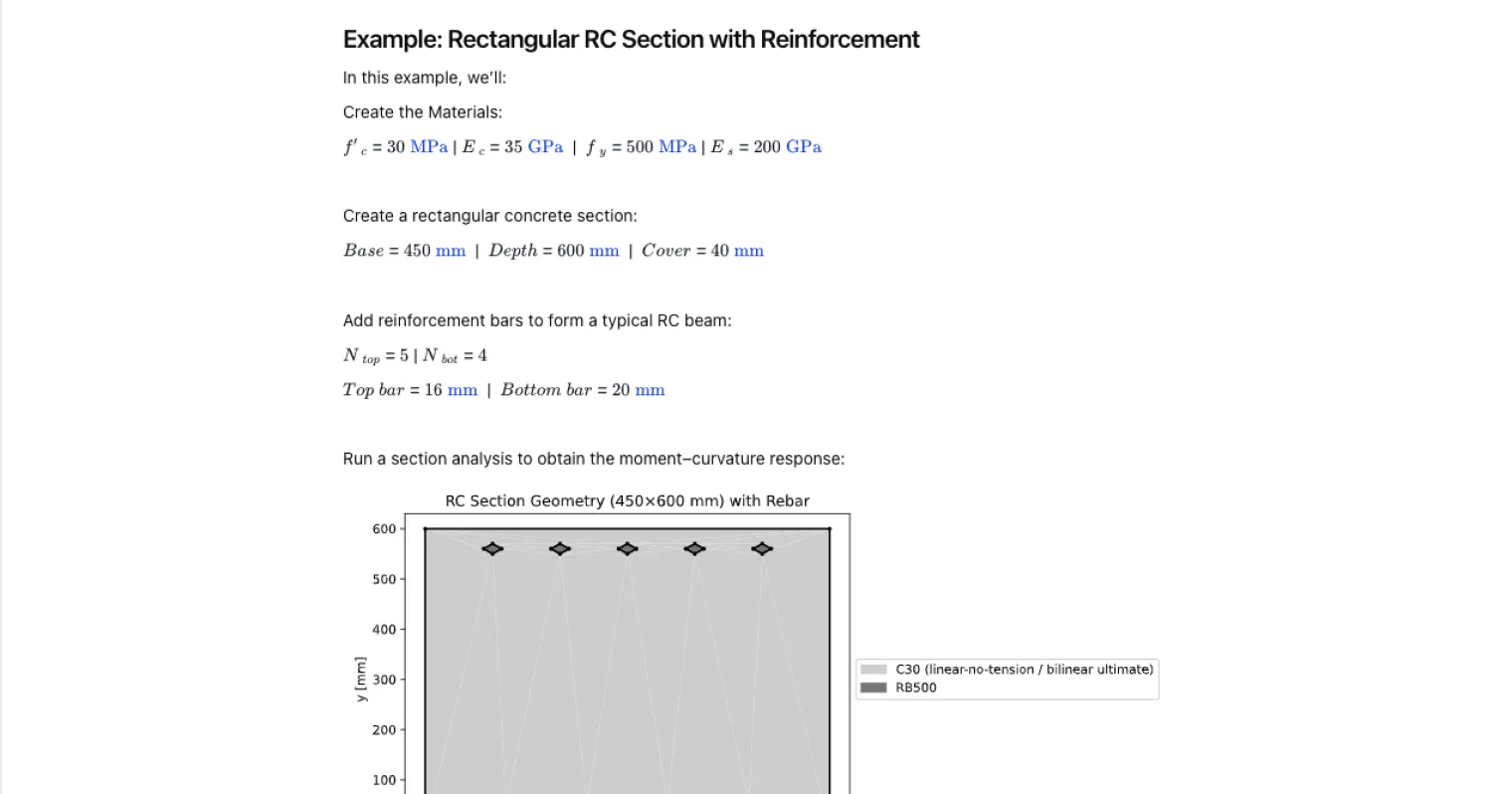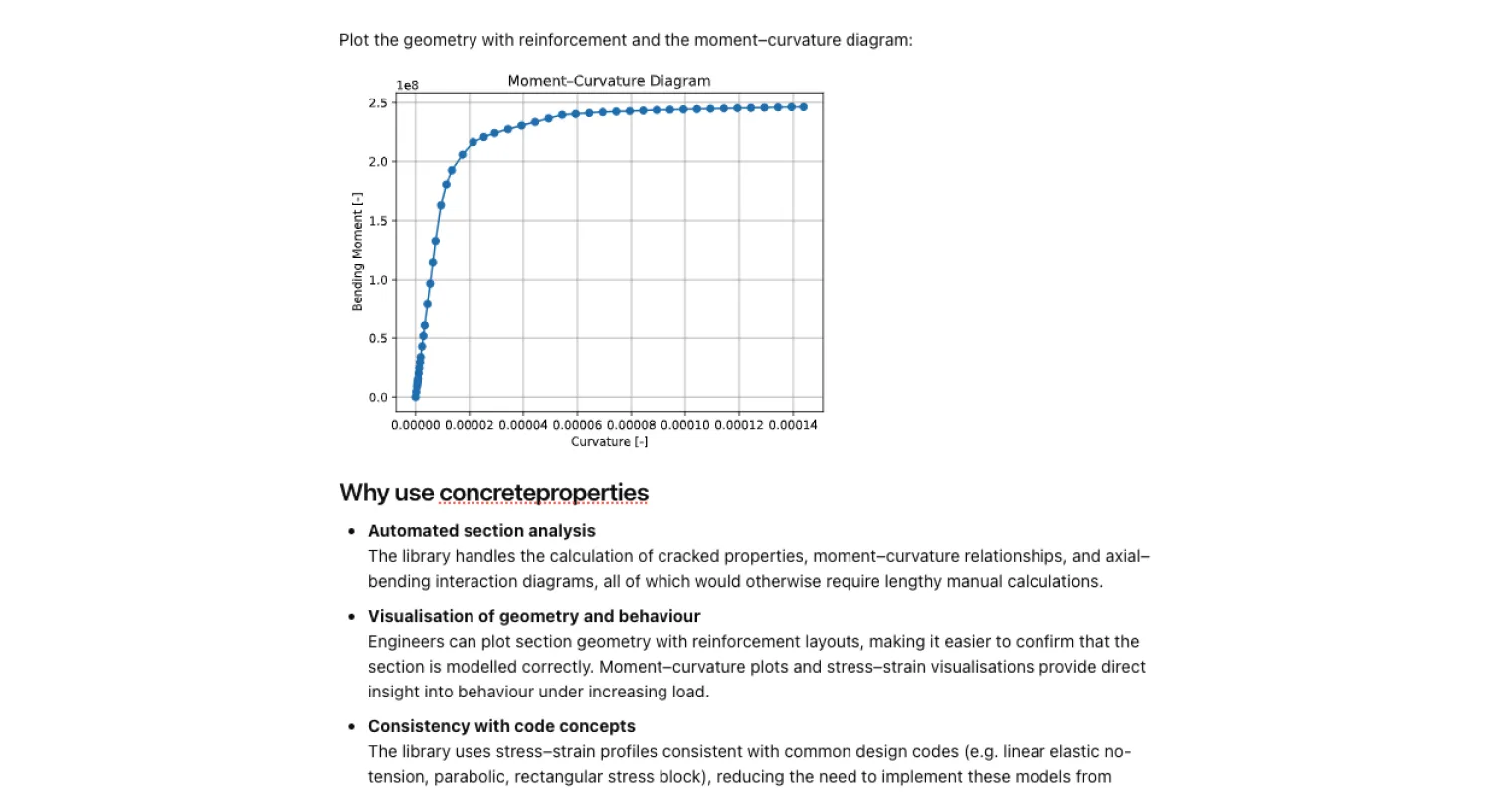Concreteproperties Python library pre-installed on CalcTree. For section properties, moment-curvature and P–M diagrams. Get started in under 1min!

This template is not available yet. You can sign up and create it yourself!
Or let us know if you'd like to be notified when it’s ready:
About this template
This template implements section analysis for reinforced concrete using a Python backend built around the concreteproperties package. It models concrete materials and steel reinforcement to return gross, cracked and ultimate concrete properties, moment–curvature response, and axial–bending interaction (including biaxial).
- Structural engineer: Rapidly check concrete beams, columns and walls, confirm geometry, rebar layout and design forces against code requirements.
- Researcher/educator: Demonstrate concrete stress–strain models, moment–curvature and P–M diagrams for teaching and reports.
- Contractor/PM: Share calculations with consultants; capture assumptions and produce a calculation record for construction projects.
Results are consistent and engineering-grade, suitable for structural concrete design workflows across various conditions.
More on Concreteproperties
What this template captures
The key inputs for the library are the section geometry, the concrete compressive strength (f’c), the modulus of elasticity, and the reinforcing steel details such as size, grade, and location. Reinforcement cover is included, and the section may be analysed under both axial load and bending actions. Unlike a mix design tool, concreteproperties does not capture details such as water content, aggregate type, slump results, or cement blends. Its focus remains on section-level inputs that govern stiffness, strength, and curvature behaviour in reinforced concrete analysis.
What the engine computes
From these inputs, the engine calculates the behaviour of the section at three levels: gross (uncracked), cracked, and ultimate. It produces stiffness properties, neutral axis depth, and flexural strength, while also performing checks against ultimate capacity. A central feature is its ability to generate full moment–curvature curves, which illustrate ductility and performance from initial loading through to failure. The library also produces axial–bending interaction diagrams, including biaxial cases for columns, as well as detailed stress and strain distribution plots. These outputs are graphical as well as numerical, supporting both calculation and interpretation during design reviews.
Materials and assumptions
The material models in concreteproperties are based on standard reinforced concrete design practice. Normal-weight concrete is assumed, with parameters defined through compressive strength and elastic modulus, while reinforcement is described by bar grade and dimensions. The package incorporates material models consistent with recognised codes, including AS 3600 and NZS 3101, enabling engineers to perform code-based analyses. However, it does not model thermal properties, creep, shrinkage, hydration, or environmental effects. Its scope is strictly structural section analysis rather than long-term durability or material science.
Practical design considerations
In practical use, concreteproperties helps engineers translate material and reinforcement inputs into reliable predictions of section stiffness, strength, and ductility. It is particularly useful for generating interaction diagrams in column design, for performing moment–curvature analysis to assess ductile performance, and for visualising cracked versus uncracked behaviour. By combining engineering definitions with clear graphical outputs, the library provides insight into how reinforced concrete sections behave under axial load and bending. While it does not replace mix design or durability modelling, it gives structural engineers a focused and efficient tool for section analysis and design verification.
Common Calculation Errors to Avoid
- Using the wrong compressive strength units: always enter cylinder strength (MPa) rather than cube strength, and check that units are consistent.
- Confusing service and ultimate properties: distinguish carefully between cracked, uncracked, and ultimate states when interpreting results such as stiffness or flexural strength.
- Incorrect reinforcement definition: mistakes in bar sizes, cover, or placement can shift the neutral axis and significantly alter stiffness, curvature, and interaction diagrams.
- Forgetting to set material grades: reinforcement grade and concrete compressive strength must be specified correctly to generate valid moment–curvature curves and strength checks.
- Assuming code defaults without verification: the library supports AS 3600 and NZS 3101 models, but you must ensure that material values and design assumptions align with the chosen code.
- Misinterpreting stress plots: stress and strain diagrams are state-dependent; using cracked-state plots for service checks, for example, can lead to wrong conclusions.
Engineering templates
Common calculators
Design guides
FAQs
What section properties does the calculator return?
It reports concrete properties at three stages: gross (uncracked) inertia, cracked stiffness using tensile strength models, and ultimate capacities using compressive strength limits. Outputs include axial capacity under compressive loads and bending resistance, plus interaction diagrams.
How are moment–curvature and P–M diagrams generated?
The solver increments curvature, computes equilibrium with steel reinforcement, and tracks stress–strain in the material. It records flexural strength, curvature at yield and crushing, and exports data and charts for review.
Can I model different material densities?
Yes. Select lightweight concrete or normal concrete and set unit weight and modulus accordingly. Reinforcement, geometry and load cases are then analysed consistently.
What does this look like in CalcTree?
You work in a live page that keeps inputs, plots and notes together. Share the link and publish a read-only view from the CalcTree templates library so collaborators can use this calculation.
Summary and References
This template provides a practical workflow for using the Concreteproperties Python package for engineers who need fast, defensible numbers on concrete structures. Use it to explore concrete properties, tune concrete mix choices, and produce plots that communicate behaviour. Run the Concreteproperties Python package in CalcTree with no need for a coding environment setup. Share with team members in a collaborative private workspace hosted on the cloud.
Learn about the benefits of using CalcTree on engineering projects!









